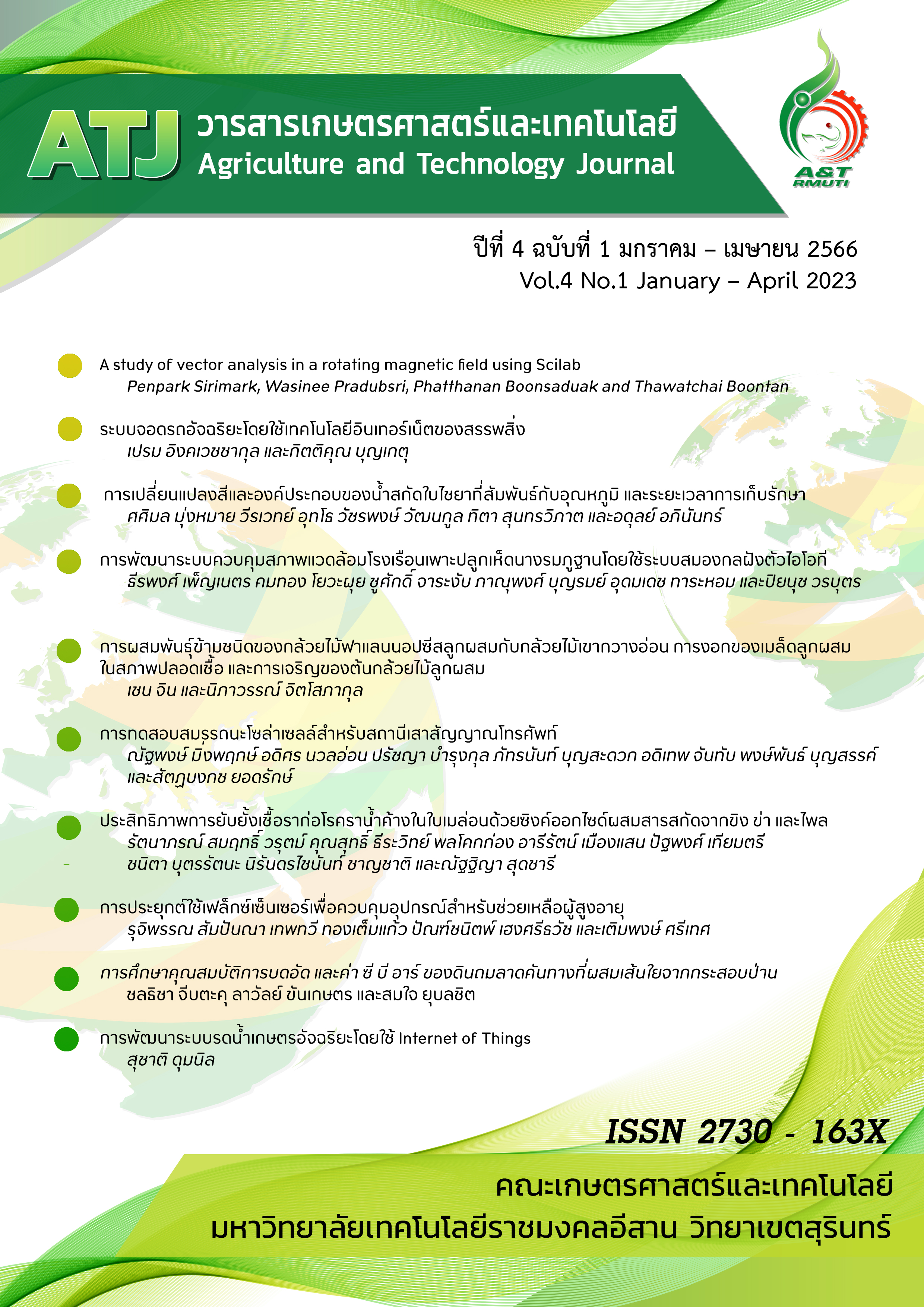การผสมพันธุ์ข้ามชนิดของกล้วยไม้ฟาแลนนอปซีสลูกผสมกับกล้วยไม้เขากวางอ่อน การงอกของเมล็ดลูกผสมในสภาพปลอดเชื้อ และการเจริญของต้นกล้วยไม้ลูกผสม
คำสำคัญ:
ปากเหลือง , ปากชมพู , ก้อนเรณู , ฝัก , โปรโตคอร์มบทคัดย่อ
การผสมพันธุ์กล้วยไม้ฟาเลนนอปซีสลูกผสมดอกสีขาวปากสีเหลือง และปากสีชมพู โดยผสมตัวเอง ผสมข้ามดอก และผสมข้ามชนิดกับกล้วยไม้เขากวางอ่อนที่มีลายบนกลีบดอกแตกต่างกันด้วยมือ ทั้งหมด 7 คู่ผสม สามารถผลิตกล้วยไม้ลูกผสมได้ 5 คู่ผสม คิดเป็นร้อยละ 71.43 โดยเกิดจากการผสมตัวเอง จำนวน 2 คู่ผสม การผสมข้ามดอก จำนวน 1 คู่ และผสมข้ามชนิด จำนวน 2 คู่ผสม อายุฝักแก่ของกล้วยไม้ลูกผสม เฉลี่ย 105 วัน หลังจากผสมพันธุ์ ฝักมีขนาดเฉลี่ยกว้าง 1 เซนติเมตร ยาว 5.7 เซนติเมตร จากการศึกษาการงอกของเมล็ดลูกผสมในสภาพปลอดเชื้อ พบว่า เมล็ดกล้วยไม้ลูกผสม 5 คู่ผสมสามารถงอกเมื่อเพาะเลี้ยงบนอาหารแข็งสูตรดัดแปลง Vacin and Went (1949) ที่เติมน้ำมะพร้าว 150 มิลลิลิตรต่อลิตร น้ำตาล 20 กรัมต่อลิตร ปรับ pH 5.2 เพาะเลี้ยงในที่มืด ที่อุณหภูมิ 25±2 องศาเซลเซียส เฉลี่ย 13.6 วัน และโปรโตคอร์มสามารถเจริญเป็นต้น เมื่อเลี้ยงบนอาหารแข็งสูตรดัดแปลง Vacin and Went (1949) ที่เติมน้ำมะพร้าว 150 มิลลิลิตรต่อลิตร กล้วยหอม 100 กรัมต่อลิตร น้ำตาล 20 กรัมต่อลิตร ผงถ่าน 1 กรัมต่อลิตร และ pH 5.2 เพาะเลี้ยงเป็นเวลา 120 วันที่อุณหภูมิ 25±2 องศาเซลเซียส ให้แสง 16 ชั่วโมงต่อวัน เมื่อย้ายต้นกล้ากล้วยไม้ลูกผสมทั้ง 5 คู่ผสมปลูกในโรงเรือน มีการรอดชีวิตร้อยละ 100 สีของใบ ขนาดของใบ และความสูงของต้นเพิ่มขึ้น ความสำเร็จของการผสมข้ามชนิดระหว่างดอกกล้วยไม้ฟาแลนนอปซีสลูกผสมดอกขาวปากเหลือง และปากชมพูกับก้อนเรณูกล้วยไม้เขากวางอ่อนซึ่งเป็นกล้วยไม้ไทย สามารถพัฒนาเป็นกล้วยไม้กระถางขนาดเล็กได้
เอกสารอ้างอิง
ครรชิต ธรรมศิริ. (2550). เทคโนโลยีการผลิตกล้วยไม้. พิมพ์ครั้งที่ 2. สำนักพิมพ์อัมรินทร์พริ้นติ้งแอนด์พับลิชชิ่ง: กรุงเทพฯ.
ชฎาพร ทรายคำ, เกวลิน คุณาศักดากุล และณัฐา โพธาภรณ์. (2563). ความสามารถในการผสมข้าม และการงอกของเมล็ดในสภาพปลอดเชื้อของกล้วยไม้ดินบางชนิดในสกุล Habenaria และ Pecteilis. วารสารเกษตร. 38(1): 47-58.
ณัฐา ควรประเสริฐ. (2548). กล้วยไม้วิทยา 1. ภาควิชาพืชสวน คณะเกษตรศาสตร์ มหาวิทยาลัยเชียงใหม่ เชียงใหม่.
เอกรัตน์ วสุเพ็ญ, ฉันทลักษณ์ ติยายน, และณัฐา โพธาภรณ์. (2564). วงจรชีวิต และความสามารถ ในการผสมพันธุ์ของกล้วยไม้เหลืองแม่ปิง. วารสารเกษตร. 37(1): 27-37.
Arditt J. (1967). Factors affecting the germination of orchid seeds. Botanical Review. 33(1): 1-97.
Devadas R., Pamarthi R.K., Meitei A.L., Pattanayak S.L. and Sherpa R. (2019). Morphological description of novel Phaius primary hybrid (Orchidaceae). Journal of Experimental Biology and Agricultural Sciences. 7: 138-47.
Kim D.H., Kang K.W., Enkhtaivan G., Jan U. and Sivanesan I. (2019). Impact of activated charcoal, culture medium strength and thidiazuron on non-symbiotic in vitro seed germination of Pecteilis radiata(Thunb.) Raf. S. South African Journal of Botany. 124: 144-50.
Kishor R. and Sharma G.J. (2008). Intergeneric hybrid in two rare and endangered orchids, Renanthera imschootiana Rolfe and Vanda coerulea Griff. ex Linn. (Orchidaceae): Synthesis and characterization. Euphytica. 165: 247-56.
Kunakhonnuruk B., Inthima P. and Kongbangkerd A. (2018). In vitro propagation of Epipactis flava Seidenf. an endangered rheophytic orchid: A first study on factors affecting asymbiotic seed germination, seedling development and greenhouse acclimatization. Plant Cell, Tissue and Organ Culture. 135: 419-32.
Parton E., Vervaeke I., Delen R., Vandenbussche B., Deroose R., and De Proft, M. (2002). Viability and storage of bromeliad pollen. Euphytics. 125: 155-161.
Prizao E.C., Goncalves L.D.M., Gutierre M.A.M., Mangolin C.A. and Machado M.D.F.P.D.S. (2012). Activated charcoal and graphite for the micropropagation of Cattleya bicolor Lindl. and a orchid double hybrid ‘BLC Pastoral Innocence’. Acta Scientiarum. Agronomy. 34: 157-61.
Proctor H.C. (1998). Effect of pollen age on fruit set, fruit weight and seed set in there orchid species. Canadian Journal of Botany. 76(3): 420–427.
Punjansing T., Nakkuntod M., Homchan S., Inthima P. and Kongbangkerd A. (2021). Production and molecular identification of interspecific hybrids between Phaius mishmensis (Lindl. and Paxton) Rchb. f. and Phaius tankervilliae (Banks) Blume. Agriculture. 11: 306.
Sinumporn P., Narumi-Kawasaki T. and Fukai S. (2020). Development of interspecific hybrids between Habenaria radiata and Habenaria rhodocheila complex. Advances in Horticultural Science. 34: 3-10.
Song J. and Tachibana S. (2007). Loss of viability of tomato pollen during long-term dry storage is associated with reduced capacity for translating polyamine biosynthetic enzyme genes after rehydration. Journal of Experimental Botany. 58(15-16): 4235-4244.
Thaithong O. (1990). Orchids of Thailand. Office of Environmental Policy and Planning, Bangkok.
Vacin E. and Went F. (1949). Some pH changes in nutrient solution. Botanical Gazette. 110(4): 605-613.
Wilfret G.J. and Kamemoto H. (1969). Genome and karyotype relationships in the genus Dendrobium (Orchidaceae) II. Karotype relationships. Cytologia. 36: 604-13.
Zahara M., Datta A., Boonkorkaew P. and Mishra A. (2017). The effects of different media, sucrose concentrations and natural additives on plantlet growth of Phalaenopsis hybrid ‘Pink’. Brazilian Archives of Biology and Technology 60: 1-15.
Zhang L.X., Chang W.C., Wei Y.J., Liu L. and Wang Y.P. (1993). Cryopreservation of Ginseng pollen. HortScience. 28(7): 742-743.
ดาวน์โหลด
เผยแพร่แล้ว
เวอร์ชัน
- 19-02-2024 (2)
- 29-04-2023 (1)
รูปแบบการอ้างอิง
ฉบับ
ประเภทบทความ
สัญญาอนุญาต
ลิขสิทธิ์ (c) 2023 วารสารเกษตรศาสตร์และเทคโนโลยี

อนุญาตภายใต้เงื่อนไข Creative Commons Attribution-NonCommercial-NoDerivatives 4.0 International License.
เนื้อหาและข้อมูลในบทความที่ลงตีพิมพ์ในวารสารทดสอบระบบ ThaiJo2 ถือเป็นข้อคิดเห็นและความรับผิดชอบของผู้เขียนบทความโดยตรงซึ่งกองบรรณาธิการวารสาร ไม่จำเป็นต้องเห็นด้วย หรือร่วมรับผิดชอบใดๆ
บทความ ข้อมูล เนื่อหา รูปภาพ ฯลฯ ที่ได้รับการดีพิมพ์ในวารสารทดสอบระบบ ThaiJo2 ถือเป็นลิขสิทธิ์ของวารสารทดสอบระบบ ThaiJo2 หากบุคคลหรือหน่วยงานใดต้องการนำทั้งหมดหรือส่วนหนึ่งส่วนใดไปเผยแพร่หรือเพื่อกระทำการใดๆ จะต้องได้รับอนุญาตเป็นลายลักอักษรณ์จากวารสารทดสอบระบบ ThaiJo2 ก่อนเท่านั้น







